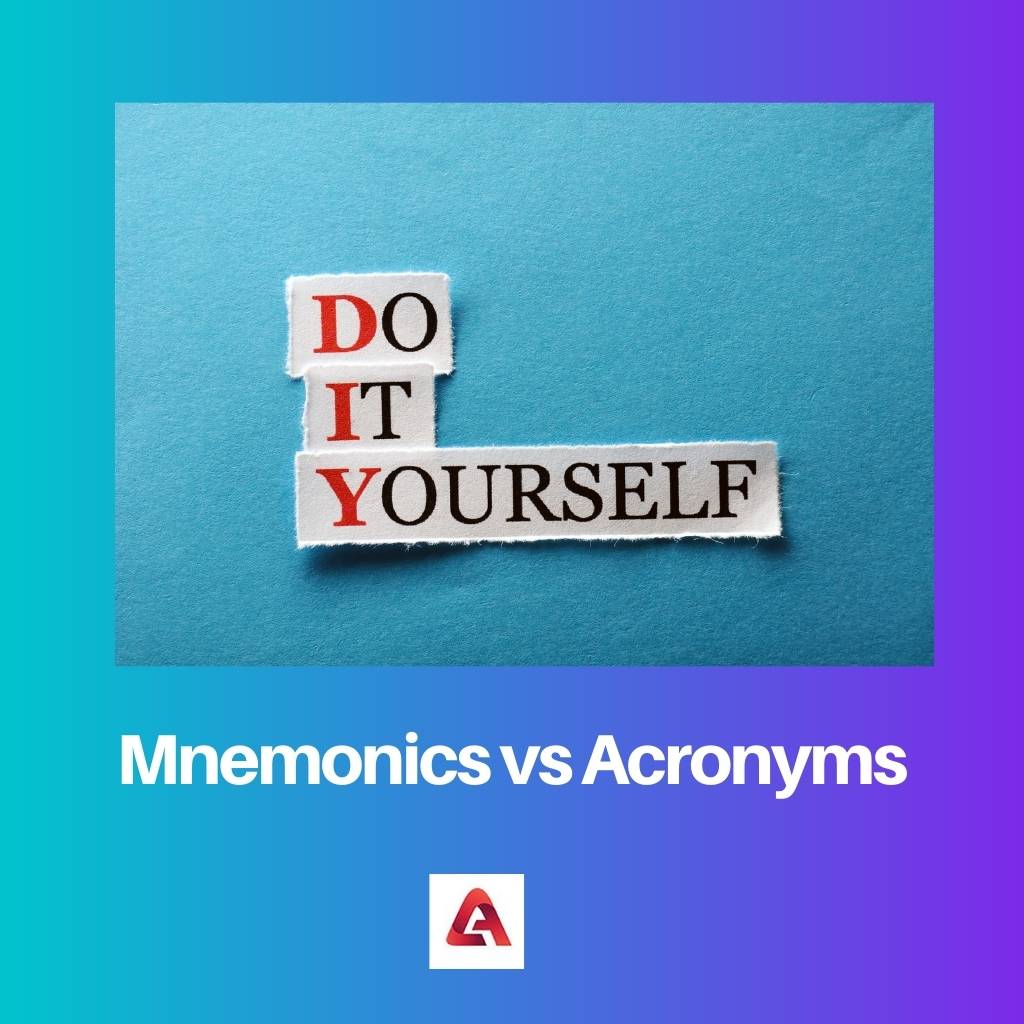For instance, mnemonics, acronyms, abbreviations, and initialisms are the methods that curtail the usage of certain longer words.
Key Takeaways
- Mnemonics are memory aids that utilize patterns, associations, or imagery to help recall information, whereas acronyms are abbreviations formed from the initial letters of a group of words.
- Acronyms can serve as a mnemonic device, but mnemonics encompass a broader range of techniques, including acrostics, rhymes, and visualizations.
- Mnemonics are applied to learning complex subjects or sequences, while acronyms are commonly used to simplify phrases or terminology in communication.
Mnemonics vs Acronyms
The difference between Mnemonics and Acronyms is that acronyms are applied to ease the use of long phrases by using the first letter of all the words in sequential order. Meanwhile, a mnemonic is a made-up name or rhyming word that is simply used to memorize certain sentences academically.

Mnemonics are the made-up names or phrases that have been taught to children in their school in a way to memorize certain universal idioms.
In contrast, the acronym is a word or name that takes the first letter of the longer component of words in a way to minimize the difficulties in grouping up longer phrases altogether.
Comparison Table
| Parameters of Comparison | Mnemonics | Acronyms |
|---|---|---|
| Meaning | Mnemonics is a learning technique where methods are used to improve human beings’ memory. In other words, Mnemonics helps to decode the information into a simple form by using imagery tools or retrieval cues. | An acronym is a word that is formed by the initial letters of a longer name or phrase. On the other hand, an acronym is also pronounced by the use of syllables, the mixture of two words or just as the word itself. |
| Etymology | The word Mnemonics was invented by Greek Sophists, poet and philosopher- Simonides of Ceos. He was created to remember the places he had been sitting in order to identify the routes. | The word Acronym is derived from the Greek roots- Acronym, which means height or summit name. |
| Pronunciation | Mnemonics is a learning strategy or method to remember a certain difficult word. Mnemonics do a simple way to recall an onerous word. | An Acronym is pronounced by saying the initial letters of a long word and making them a short new word. |
| Other languages | Mnemonics are used in Music to remember the rhythms, acronyms, Expressions, Models, Note Organization Images, Connection, Spelling, visualisation and Ode Mnemonics which are helpful for a person to improve the memory by using these techniques. | An acronym is used in Chinese, Korean, Japanese, German, Hebrew, Indonesian, Russian, Swahili and Vietnamese. Besides, it is originally mentioned in English. |
| Examples | Short notes are the best way to remember a tedious lecture. | NASA is pronounced as Nah-saa instead of its entire word- National Aeronautics and Space Administration. |
What is Mnemonics?
Mnemonic is a type of knowledge that uses innovative approaches in a way to make it strong for the people to commemorate.
It is a Greek word that relates to the concept of memorizing something and is therefore called the art of memory in this contemporary education system.
Furthermore, mnemonic has various types of ways to acknowledge the memorization process, such as by using music, names as in VIBGYOR (Violet, Indigo, Blue, Green, Yellow, Orange, and Red in Rainbow), expressions or wordings, models, ode, notes, connecting two relatable things for strong understanding, visualization, and spelling.
For instance, as in ARITHMETIC, for A rat in the house may eat the ice cream, the order of the planets in the solar system is represented by ‘My very excited mother just served us nine pies’, knuckles method for the pattern of the months, and more.
What is Acronyms?
As earlier pointed out, an acronym is a word or a phrase that uses the initial letter of each term in the longer component of words to keep in mind certain expressions.
Unlike initialisms, which are pronounced by emphasizing each word, the pronunciation of acronyms is uttered by enunciating the whole word instead of naming each alphabet.
For instance, NASA is a well-known example of an acronym called the National Aeronautical and Space Administration. Here the initial letter of each of the words in the phrase is taken into consideration.
Other examples are ASAP for As Soon As Possible, PIN for Personal Identification Number, NATO for The North Atlantic Treaty Organization, YOLO for You Only Live Once, and more.
Main Differences Between Mnemonics and Acronyms
- Mnemonics are used as various methods to recall difficult learning, such as Expressions, Acronyms, Models, Notes Connection, Spelling, Visualization, and Ode Mnemonics.
- When it comes to Mnemonic, short notes, flow chart, mind map or memorising months with the help of Knuckles method.



